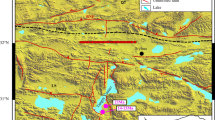Abstract
Magnetotelluric studies over the Bundelkhand craton indicates a high resistivity sub-structure, typically observed in the Archean-Proterozoic regions. The geoelectric section shows a single high resistivity layer in the northern part of the craton, extending from surface to a depth of about 60 km and a three layered resistivity structure overlying a conductive bottom in its southern part. The geological studies reported earlier have delineated an EW trending zone of ultramafic rocks, called the Bundelkhand tectonic zone (BTZ), which marks the divide between the two electrical resistivity patterns. The geoelectric structure is broadly indicative of a northward dipping tectonic fabric in this region which conforms to the Himalayan subduction, to the immediate north of this craton. However this observation cannot explain the findings from geochemical, isotope analysis and geological studies, suggesting possible vertical block movements in the region, which are also indicated in the Bouguer gravity studies. The geoelectric structure beneath the Vindhyan group to the south shows low resistivities even up to 60 km, suggesting that the Bundelkhand craton which is characterized by high resistivity rocks, does not extend to the south beneath the Vindhyans, as was believed by the earlier researchers. A low resistivity body with an extremely high conductance of about 100,000 Siemens is delineated at the mid crustal depths beneath the exposed Bijawars south of Bundelkhand craton. The causative factors behind this low resistivity are not immediately apparent, but some possibilities are discussed here.
Similar content being viewed by others
References
Agarwal, B.N.P., Das, L.K., Chakravorty, K. and Sivaji, Ch. (1993) Analysis of the Bouguer anomaly over Central India: A regional perspective. Mem. Geol. Soc. India, no.31, pp.469–493.
Gokarn, S.G., Rao, C.K., Gupta, G., Singh, B.P. and Yamashita, M. (1901) Deep crustal structure in central India using magnetotelluric studies. Geophys. Jour. Internat., v.144, pp.685–694.
Groom, R.W. and Bailey, R.C. (1989) Decomposition of the magnetotelluric impedance tensor in the presence of local three-dimensional galvanic distortions. Jour.Geophys Res., v.94, pp.1913–1925.
Kaila, K.L, Murty, P.R.K., Mall, D.M., Dixit, M.M. and Sarkar, D. (1987) Deep seismic sounding along Hirapur-Mandla profile, central India. Geophys. Jour. Royal. Astr. Soc., v.89, pp.399–404.
Malviya, V.P., Makoto, A., Pati, J.K. and Kaneko, Y. (1906) Petrology and geochemistry of metamorphosed basaltic pillow lava and basaltic Komatiite in the Mauranipur area: subduction related volcanism in the Archean Bundelkhand craton, Central India. Jour. Miner. Petrol. Sci., v.101, pp.199–217.
Pati, J.K., Patel, S.C., Pruseth, K.L., Malviya, V.P., Arima, M., Raju, S., Pati, P. and Prakash, K. (1907) Geology and Geochemistry of giant quartz veins from the Bundelkhand Craton, Central India and their implications, Jour. Earth. Syst. Sci., v.116(6), pp.497–510.
Qureshy, M.N. and Warsi, W.E.K. (1975) Role of regional gravity surveys in a concept oriented exploration programme. Jour. Geol. Soc. India, v.16, pp.44–54.
Raval, U. and Veeraswamy, K. (1907) Within and beyond the Protocontinents: Some geophysical aspects reflecting geodynamics of the Indian continental lithosphere, Int. Assoc. Gondwana Res. Mem. No.10, pp.263–285
Ravi Shankar, (1988) Heat flow map of India and discussions on its geological and economic significance. Indian Minerals, v.42, pp.89–110.
Rodi, W. and Mackie, R.L. (1901) Nonlinear conjugate gradients algorithm for 2D magnetotelluric inversions. Geophysics, v.66, pp.174–187.
Senthiappan, M. (1981) Geology of the area along Raksa Shear zone, Jhansi District, Uttar Pradesh. Geol. Surv. India Spec. Publ., no.3, pp.73–76.
Sharma, K.K. and Rahman, (1900) The early archaeanpalaeoproterozoic crustal growth of the Bundelkhand craton. In: M. Deb (Ed.), Northern Indian Shield. Narosa Publishing House, New Delhi, pp.51–72.
Singh, S.P., Singh, A.N. and Singh, Y. (1907) Lineament fabrics and major shear zones in Bundelkhand and tectonic interpretation from IRS-ID data. Himalayan Geology, Abstract vol.28, pp.47.
Author information
Authors and Affiliations
Corresponding author
Additional information
Deceased, Feb. 2011
Rights and permissions
About this article
Cite this article
Gokarn, S.G., Rao, C.K., Selvaraj, C. et al. Crustal evolution and tectonics of the Archean Bundelkhand craton, Central India. J Geol Soc India 82, 455–460 (2013). https://doi.org/10.1007/s12594-013-0176-6
Received:
Accepted:
Published:
Issue Date:
DOI: https://doi.org/10.1007/s12594-013-0176-6




